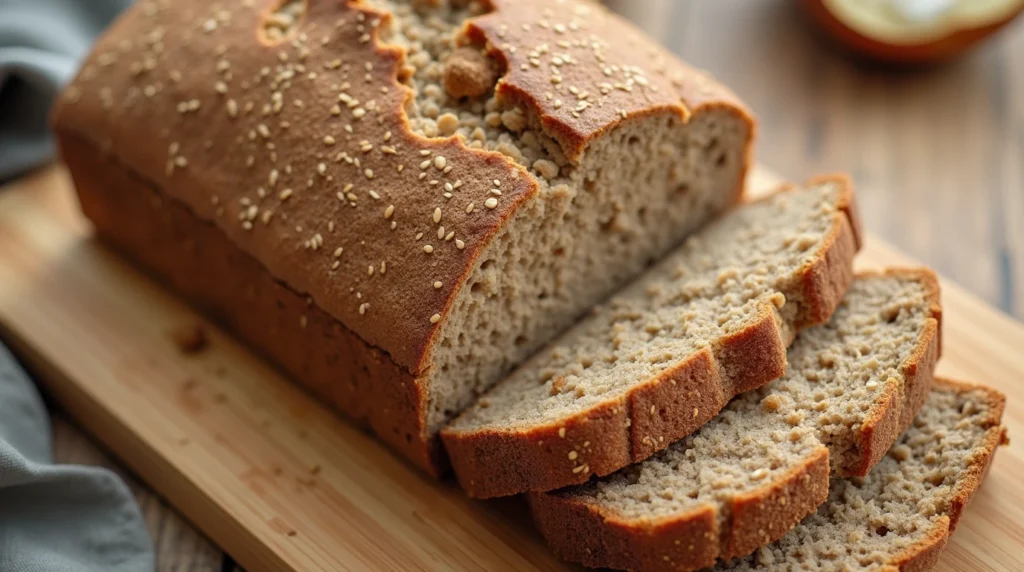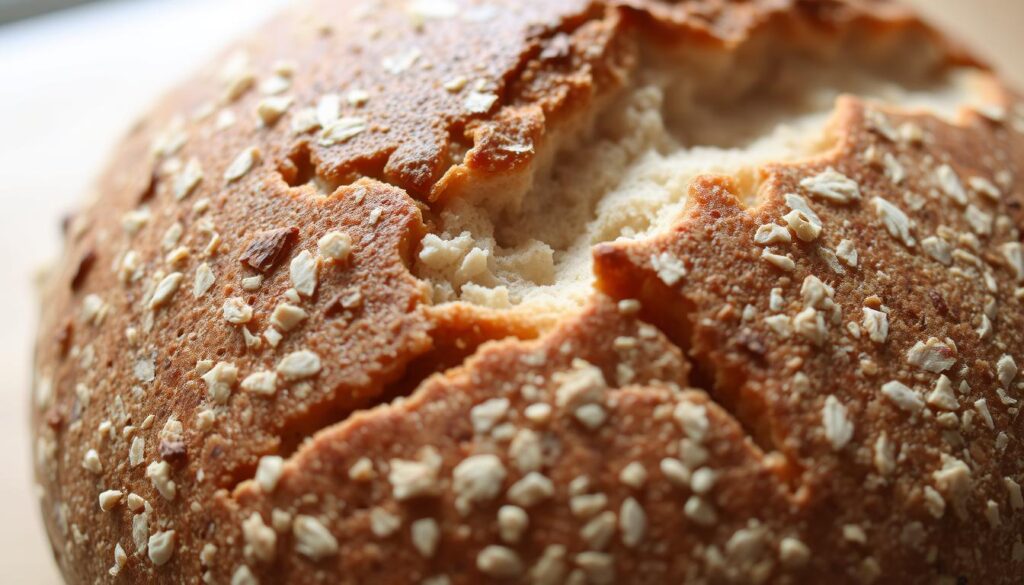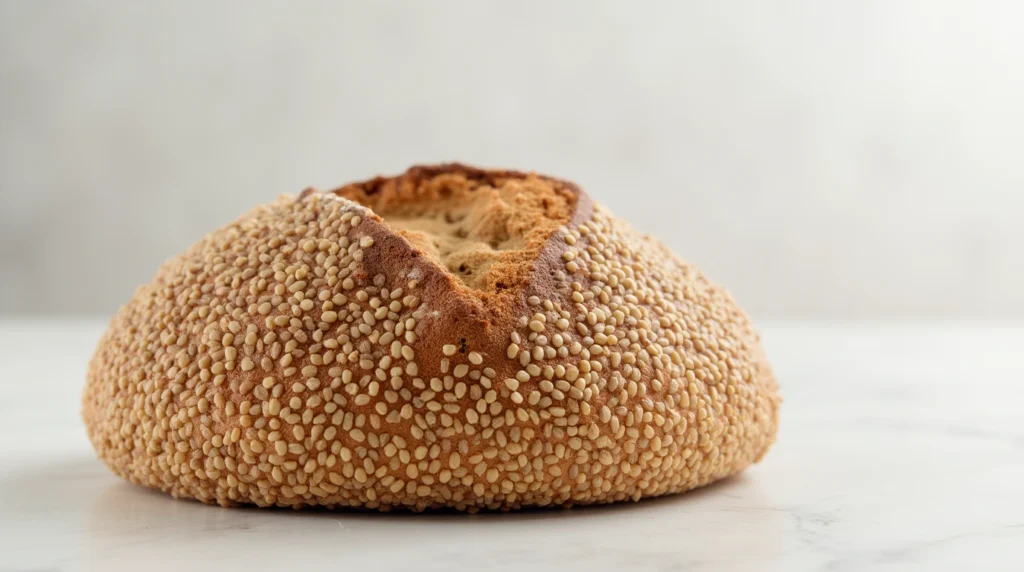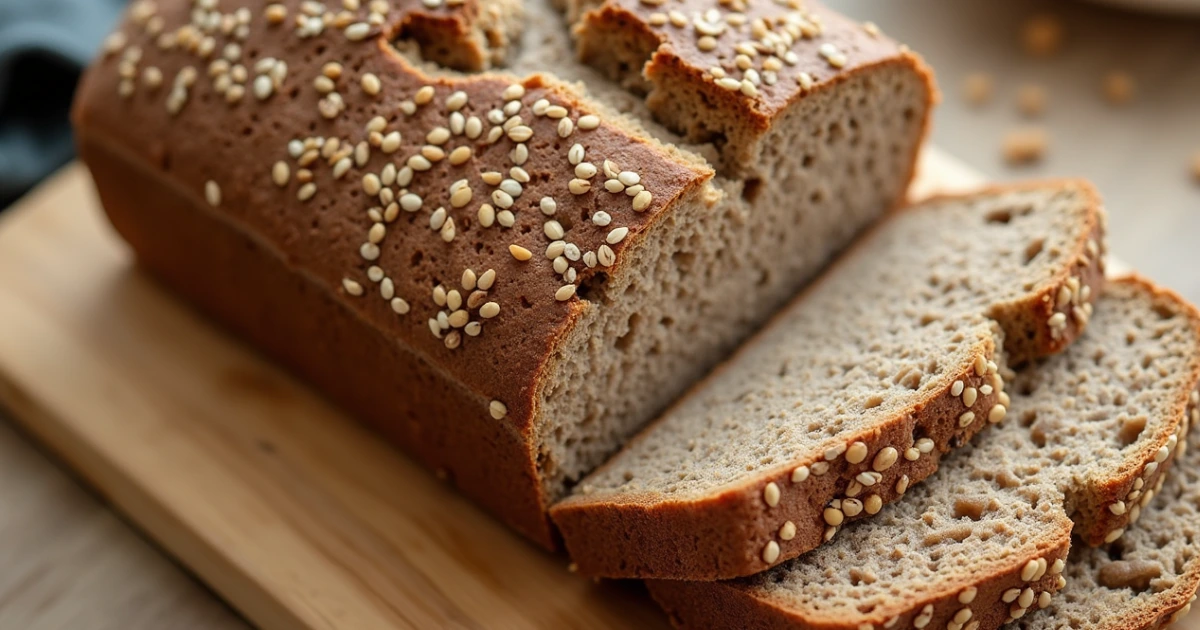Delicious Buckwheat Bread Recipe – Healthy & Gluten-Free!
I’ve always looked for healthy bread options. That’s how I found buckwheat bread. It’s gluten-free and packed with nutrients. Making it has been a fun and educational experience, and I’m eager to share it with you.
This guide will cover everything about buckwheat bread. We’ll look at its health benefits, the ingredients you need, and how to bake it perfectly. If you’re looking for a healthier bread choice or want to try something new, this article will help you make delicious buckwheat loaves.
Table of Contents
Introduction to Buckwheat Bread
Buckwheat bread is becoming more popular in the U.S. as a healthy, gluten-free option. It comes from the buckwheat plant and has a unique taste. It’s also packed with good stuff that makes it great for bread.
Buckwheat isn’t wheat at all. It’s a fruit seed, like rhubarb and sorrel. So, buckwheat flour is gluten-free. This makes it perfect for people with gluten issues. As more people look for gluten-free foods, buckwheat bread is a top pick.
Buckwheat bread is also super nutritious. It’s full of vitamins, minerals, and fiber. This makes it a better choice than regular wheat flour. It’s great for those who want to eat healthier, plant-based foods.
Next, we’ll dive into what makes buckwheat flour special. We’ll talk about the ingredients and tools you need for buckwheat flour bread. Plus, we’ll give you a step-by-step guide to making the perfect loaf. This guide is for both experienced bakers and those new to gluten-free baking. It will help you make delicious, healthy buckwheat flour bread at home.

What Makes Buckwheat Flour Special for Bread Making
Buckwheat flour is a unique ingredient for homemade bread. It has a different nutritional profile and taste than traditional wheat flour. Let’s look at what makes buckwheat flour special for making delicious bread.
Nutritional Profile of Buckwheat Flour
Buckwheat flour is full of nutrients that are good for you. It has protein, fiber, and minerals like magnesium, iron, and zinc. Plus, it’s gluten-free, which is great for people with gluten issues.
Gluten-Free Properties
Buckwheat flour doesn’t have gluten, which is a big plus for bakers looking for a wheat-free option. This means you can make light and airy bread without wheat. It’s perfect for those who can’t eat gluten or prefer not to.
Flavor Characteristics
Buckwheat flour has a nutty, earthy flavor that makes bread taste better. This unique taste can go well with many ingredients. It makes buckwheat flour bread recipes stand out.
| Nutrient | Amount per 100g |
| Protein | 13.25g |
| Fiber | 10g |
| Magnesium | 168mg |
| Iron | 2.2mg |
| Zinc | 2.8mg |
Discovering buckwheat flour’s special qualities is key to making amazing buckwheat flour bread recipes. Knowing its nutritional benefits, gluten-free status, and unique taste opens up new possibilities in bread making.
Essential Ingredients for Buckwheat Bread
Making tasty buckwheat bread needs the right ingredients. At the center is buckwheat flour. It gives the bread a rich, earthy taste and a special texture.
For a great homemade loaf, you’ll also need:
- Eggs – They add structure and richness to the dough, making it tender.
- Milk or alternative milk – This adds moisture and softness to the bread.
- Yeast – It makes the bread rise and gives it an airy feel.
- Salt – A little salt boosts the bread’s flavor.
- Oil or butter – A bit of fat makes the dough soft and easy to work with.
- Sweetener (optional) – Honey, maple syrup, or brown sugar can sweeten the bread.
Choosing and mixing these key buckwheat bread ingredients will help you bake a wonderful loaf. It will highlight the special qualities of this gluten-free flour.
Basic Equipment Needed for Baking Buckwheat Bread
To bake delicious buckwheat bread at home, you need a few key tools. Whether you mix and knead by hand or use a bread machine, the right equipment is crucial. It helps you make the perfect loaf.
Manual Baking Tools
If you love making bread by hand, you’ll need these tools:
- A large mixing bowl for combining ingredients
- A sturdy wooden spoon or dough whisk for mixing
- A kneading surface, like a floured countertop or wooden board
- A bread loaf pan or baking sheet for shaping and baking
- A reliable oven thermometer for accurate temperatures
Bread Machine Requirements
If you prefer a bread machine, make sure it has these features:
- A gluten-free or buckwheat-specific bread cycle
- The ability to handle buckwheat flour’s unique texture and rising
- A non-stick bread pan for easy loaf removal
Optional Equipment
While not essential, these tools can enhance your baking:
- Bread lame or scoring knife for decorative slashes
- Bread proofer or proofing basket for better rising control
- Instant-read thermometer to check bread’s internal temperature
With the right tools, you’re ready to bake tasty buckwheat bread. It will highlight the unique flavor and texture of this versatile ingredient.
Step-by-Step Guide to Making Buckwheat Bread
Making buckwheat bread at home is simple. Follow this guide to make a loaf that’s healthy and tasty.
- Gather your ingredients: buckwheat flour, yeast, water, salt, and any additional mix-ins like honey or seeds.
- In a large mixing bowl, combine the dry ingredients – buckwheat flour, yeast, and salt – and whisk to blend.
- Slowly add the warm water, mixing until a shaggy dough forms. Knead the dough for about 10 minutes, until it becomes smooth and elastic.
- Place the dough in a greased bowl, cover, and let it rise for 1-2 hours, or until it has doubled in size.
- Punch down the dough to release any air bubbles, then shape it into a loaf and place it in a greased loaf pan.
- Cover the pan and let the dough rise for another 30-60 minutes.
- Preheat your oven to 375°F (190°C).
- Bake the buckwheat bread for 30-40 minutes until it turns golden brown, and a toothpick inserted into the center emerges clean.
- Take the bread out of the oven, let it rest in the pan for about 10 minutes, then move it to a wire rack to fully cool before slicing and serving.
With this buckwheat bread recipe, you can enjoy its nutty flavor and health benefits. Try different mix-ins or toppings to make your buckwheat bread even more delicious.
Tips for Perfect Buckwheat Bread Texture
Making perfect buckwheat bread is an art. It requires a few key tips. These include controlling moisture, kneading right, and setting proper rising times. Let’s dive into the secrets for a delicious, bakery-like crumb.
Moisture Control
Buckwheat flour absorbs more liquid than regular flour. Accurate measurement of liquid ingredients is essential. Start with the recommended amount of water or milk. Add more if the dough feels too dry.
A slightly tacky dough is better. It ensures a moist, tender crumb.
Kneading Techniques
Kneading your buckwheat dough well is essential. Since buckwheat flour lacks gluten, it needs more kneading. Knead for 5-10 minutes, stretching and folding the dough with your heel.
This process helps create a light, airy texture in your loaf.
Proper Rising Times
Letting your dough rise to the right volume is crucial. Aim for a first rise of 45-60 minutes, until it doubles in size. After shaping, give it 30-45 minutes to rise before baking.
Overproofing can make the bread dense and gummy. So, watch the time closely.
With these buckwheat bread texture and baking tips, you’ll soon master the crumb of your homemade buckwheat bread. Remember, patience and practice are key to achieving that artisanal look and feel.

Common Mistakes to Avoid When Baking Buckwheat Bread
Baking buckwheat bread can be rewarding but comes with challenges. Let’s look at common buckwheat bread troubleshooting issues and how to avoid them.
One big problem is improper hydration. Buckwheat flour interacts with liquids differently from wheat flour. Achieving the correct balance of wet and dry ingredients is crucial. Under or overkneading can also cause baking errors, making the loaf dense and heavy.
- Make sure to measure ingredients accurately, especially water or milk, and adjust as needed.
- Knead the dough well but don’t overdo it. Too much kneading can make the bread tough.
Another issue is insufficient proofing. Buckwheat bread needs more time to rise than wheat bread. If you rush it, you’ll get a flat, dense loaf.
- Let the dough rise for the full time recommended. Be patient during this step.
- Watch the dough’s progress and adjust the rising time if your kitchen’s temperature and humidity are different.
| Common Mistake | Potential Issue | Solution |
| Incorrect Hydration | Dense, heavy texture | Adjust wet and dry ingredients to achieve the right consistency |
| Improper Kneading | Tough, chewy crumb | Knead the dough well but avoid overdoing it to maintain the right texture |
| Insufficient Proofing | Flat, dense loaf | Let the dough rise as recommended for optimal results |
By fixing these common buckwheat bread troubleshooting issues, you’ll bake perfect, tasty buckwheat bread every time.
Storing and Preserving Your Buckwheat Bread
Keeping your homemade buckwheat bread fresh and flavorful is key. Whether you baked it for now or later, there are ways to keep it tasting great. These methods work well for your gluten-free bread.
Room Temperature Storage
For a short time, store your buckwheat bread at room temperature. Use a clean towel or paper bag to wrap it. This keeps the bread’s texture and lets it breathe. Don’t use airtight containers, as they can make the bread spoil faster.
Freezing Methods
Freezing is great for longer storage. Arrange the sliced bread on a baking sheet. After freezing, place the slices in a bag or container for storage. This stops them from sticking together, making it easy to reheat what you need.
Reheating Tips
- To reheat frozen buckwheat bread slices, just put them in a toaster or oven at 350°F (175°C) for a few minutes.
- For a fresher feel, mist the slices with water before reheating. This adds moisture.
- If you want softer bread, wrap slices in foil or a damp paper towel before reheating. This steams the bread.
By using these storage and reheating tips, you can enjoy your buckwheat bread for days or weeks.
Variations of Traditional Buckwheat Bread
Buckwheat bread is a canvas for bakers to try new flavors and ingredients. It’s not just the classic loaf. You can make exciting variations that make this gluten-free bread special.
Try flavored buckwheat bread for a twist. Enhance the dough by adding herbs, spices, or dried fruit for extra flavor. Imagine a loaf with rosemary and garlic or one with dried apricots and honey. These loaves are not just tasty but also show how versatile buckwheat flour is.
If you want something heartier, try seeded buckwheat bread. Add seeds like flax, chia, or sunflower. This bread is not only good-looking but also full of fiber, protein, and healthy fats.
| Buckwheat Bread Variation | Ingredients | Flavor Profile |
| Herbed Buckwheat Bread | Buckwheat flour, fresh rosemary, garlic, olive oil | Savory, aromatic |
| Cranberry Walnut Buckwheat Bread | Buckwheat flour, dried cranberries, walnuts, maple syrup | Sweet, nutty |
| Seeded Buckwheat Bread | Buckwheat flour, flax seeds, chia seeds, sunflower seeds | Nutty, wholesome |
Trying different buckwheat bread variations lets you make loaves that fit your taste and diet. Whether you prefer savory or sweet, the options are endless with this flour.

Health Benefits of Buckwheat Bread
Buckwheat bread is not just tasty, it’s also good for you. It’s a great gluten-free option that boosts your health. It promotes digestion and provides valuable nutrients.
Digestive Benefits
Buckwheat flour is full of fiber. This is key for a healthy gut. It keeps your bowels regular and lowers constipation risk. It also supports good gut bacteria.
Nutritional Advantages
Buckwheat bread is packed with nutrients. It has plenty of protein and all essential amino acids. It’s also rich in vitamins, minerals, and antioxidants.
Dietary Considerations
- Gluten-free: Buckwheat is naturally gluten-free, making it a suitable choice for individuals with celiac disease or gluten sensitivities.
- Low-Glycemic Index: Buckwheat has a low glycemic index, meaning it does not cause significant spikes in blood sugar levels, making it a great option for those with diabetes or those looking to maintain stable blood sugar levels.
- Allergen-friendly: Buckwheat is free from common food allergens, such as wheat, dairy, and nuts, making it a safe choice for those with multiple food allergies.
Adding buckwheat bread to your diet can improve digestion and nutrition. It’s perfect for those on a nutritious gluten-free diet or just looking for tasty, healthy bread options.
Adapting Buckwheat Bread for Dietary Restrictions
Buckwheat bread is both versatile and nutritious. But, what if you have specific dietary needs? Don’t worry, you can still enjoy its flavors and health benefits. Just make a few simple changes to fit your dietary preferences.
Vegan Buckwheat Bread
For vegans, making buckwheat bread is easy. Instead of eggs, use a flax or chia “egg.” Mix 1 tablespoon of ground flax or chia seeds with 3 tablespoons of water. This plant-based binder keeps your bread together without losing flavor or texture.
Low-Carb Buckwheat Bread
Buckwheat is gluten-free but still has carbs. To make low-carb buckwheat bread, replace some buckwheat flour with almond or coconut flour. Start by using up to 25% of these low-carb flours. Then, adjust the recipe to get the right consistency and rise.
| Dietary Restriction | Recommended Substitutions |
| Vegan | Flax or chia “egg” (1 Tbsp ground flax/chia + 3 Tbsp water) |
| Low-Carb | Up to 25% almond or coconut flour instead of buckwheat flour |
With a few tweaks, you can enjoy vegan buckwheat bread or low-carb buckwheat bread. These changes let you stick to your diet while still enjoying delicious bread. Experiment to find the perfect mix for your taste and lifestyle.
Best Serving Suggestions and Pairings
Buckwheat bread is super versatile. It’s great for breakfast, sandwiches, and as a side dish. This gluten-free bread opens up a world of flavors for you to try.
Breakfast Options
Begin your morning with buckwheat bread. Toast it and add avocado, honey, and sea salt for a tasty start. Or, try it with a soft-boiled egg, Greek yogurt, and herbs for a protein-rich meal.
Sandwich Ideas
- Pair grilled cheese with melted cheddar alongside a bowl of tomato soup
- Turkey and Swiss with whole-grain mustard
- Roasted vegetable and hummus for a vegetarian delight
Accompaniments
| Pairing | Description |
| Hearty Soups | Buckwheat bread’s nutty taste goes well with soups like lentil or butternut squash. |
| Seasonal Salads | Pair buckwheat bread with fresh salads for a complete meal. |
| Cheese Boards | It’s perfect for cheese boards, with various cheeses and fruits. |
Try these ideas to make your buckwheat bread experience better. You’ll find new ways to enjoy this healthy and tasty bread every day.
Troubleshooting Your Buckwheat Bread Recipe
Baking with buckwheat flour can be rewarding but also challenging. If you’re having trouble with your buckwheat bread recipe, don’t worry. We’re here to help you solve common problems.
Crumbly Texture
One common issue is a crumbly, dry texture. This might happen if you use too much buckwheat flour or not enough liquid. To fix it, try adding more water, milk, or other liquids to your recipe. You can also add an extra egg or a tablespoon of ground flaxseed to help the dough stick together.
Dense and Heavy Loaf
If your bread is dense and heavy, it might be because the dough wasn’t kneaded enough or didn’t rise well. Make sure to knead the dough for the right amount of time. Also, give it enough time to rise before baking. Adding a bit of baking powder or yeast can help it rise better.
Gummy or Sticky Texture
A gummy or sticky texture means there’s too much moisture. Try using less liquid or baking it for longer to let moisture evaporate. Adding a bit more buckwheat flour can also help soak up excess moisture.
Bitter or Nutty Flavor
Buckwheat flour can sometimes give bread a bitter or nutty taste. To lessen this, toast the buckwheat flour before using it. This can soften the flavor. You can also mix it with other gluten-free flours like rice or almond flour to balance the taste.
Remember, baking with buckwheat flour takes some trial and error to get it right. By tackling these common issues, you’ll soon enjoy making delicious homemade buckwheat bread.
Using a Bread Machine for Buckwheat Bread
Using a bread machine to make buckwheat bread is easy. These machines make the process simple, letting you enjoy buckwheat bread’s unique taste and health benefits. Here’s what you need to know to make the perfect loaf.
Machine Settings
Choosing the right settings is key when baking buckwheat bread in a machine. Use the “gluten-free” or “whole grain” cycle. These settings handle buckwheat flour’s density well. Make sure the machine is set for the right loaf size and crust color.
Recipe Modifications
Many bread machine recipes can be tweaked for buckwheat flour. You’ll need to add more liquid, like water or milk, because buckwheat absorbs a lot. You might also need to add extra leavening agents, like baking powder or yeast, to help the bread rise. Find the right mix for your machine and the texture you want.
Timing Considerations
Baking buckwheat bread in a machine might take longer than usual. You’ll need a longer kneading cycle to mix the buckwheat well. And, it might take longer to rise. Watch the process closely and make small adjustments as needed to get the best results.
FAQ
What is buckwheat bread?
Buckwheat bread is a gluten-free, nutritious bread. It’s made with buckwheat flour. It offers a nutty flavor with a dense, hearty texture.
What are the benefits of using buckwheat flour for bread?
Buckwheat flour is full of fiber, protein, and nutrients like magnesium and B vitamins. It’s gluten-free, which is great for those with gluten issues. Its unique taste and texture make the bread better.
What are the key ingredients needed to make buckwheat bread?
You need buckwheat flour, water, yeast, and a binder like eggs or flax seeds. You can also add honey, oil, or herbs for extra flavor and texture.
What equipment is required for baking buckwheat bread?
You’ll need a mixing bowl, dough hook, bread pan, and oven for manual baking. If using a bread machine, check it can handle buckwheat flour.
How do you make buckwheat bread from scratch?
Mix dry and wet ingredients, knead the dough, let it rise, and then bake. Follow a recipe closely for the best results.
What are some tips for achieving the perfect buckwheat bread texture?
Control moisture, knead right, and let it rise long enough. Try different moisture levels and rising times to get it just right.
What are common mistakes to avoid when baking buckwheat bread?
Avoid over-kneading, under-proofing, and wrong oven settings. Stick to the recipe and adjust as needed for perfect bread.
How should you store and preserve buckwheat bread?
Keep at room temperature for a few days, or freeze for extended storage. Wrap tightly to prevent freezer burn. Thaw at room temperature or gently warm in the oven before serving.
What are some variations of traditional buckwheat bread?
Try adding seeds, nuts, herbs, or dried fruits for different flavors. These add interest and unique tastes to your bread.
What are the health benefits of buckwheat bread?
It’s nutritious, improving digestion and blood sugar control. It is rich in antioxidants and vital nutrients. It’s good for gluten-free, vegan, or low-carb diets.
How can you adapt buckwheat bread for different dietary needs?
Modify ingredients and baking methods for vegan, low-carb, or keto diets. This way, you can enjoy it without compromising taste or texture.
What are the best ways to serve and enjoy buckwheat bread?
Enjoy it toasted with avocado or nut butter, in sandwiches, or with soups and stews. Be creative with your serving ideas.
How can you troubleshoot issues when baking buckwheat bread?
If your bread is dense or dry, or has a burnt crust, check your recipe and methods. Pay attention to detail and experiment to get it right.
Can you use a bread machine to make buckwheat bread?
Yes, you can use a bread machine. Just adjust settings, ingredients, and times for the best results with buckwheat flour.

